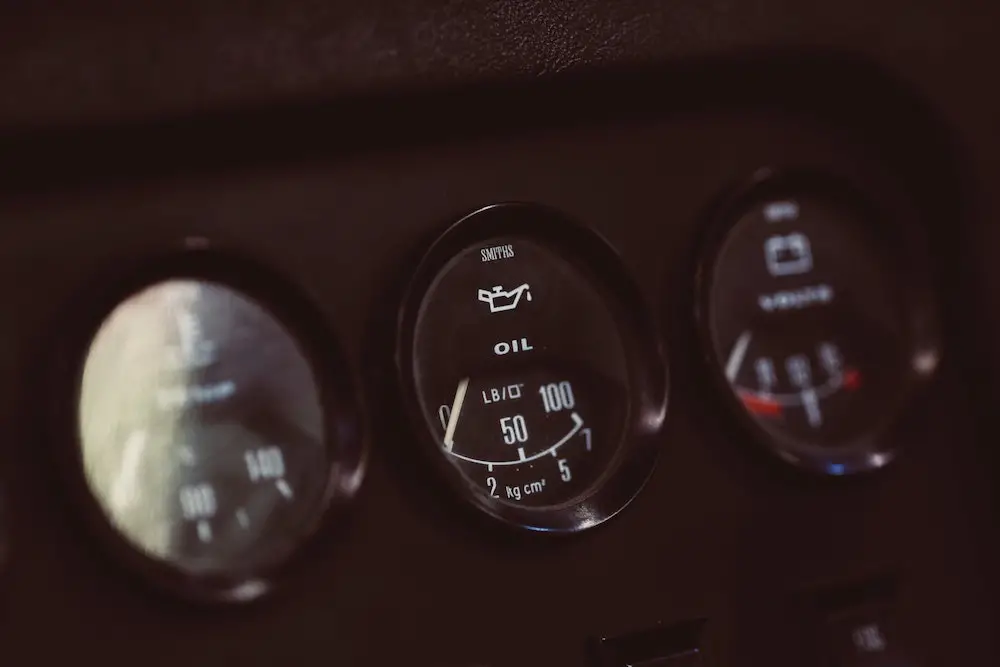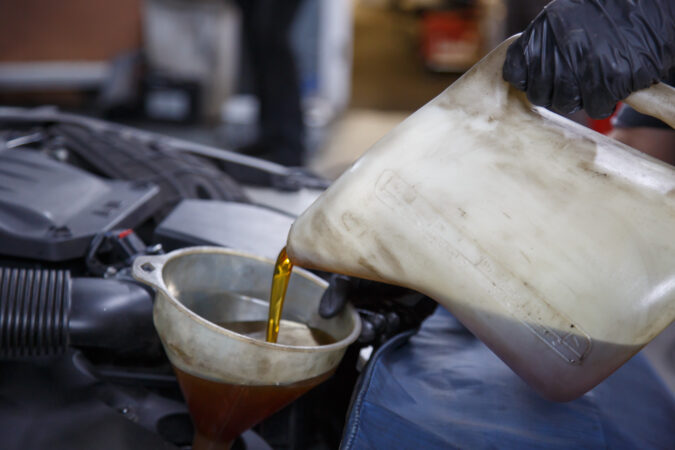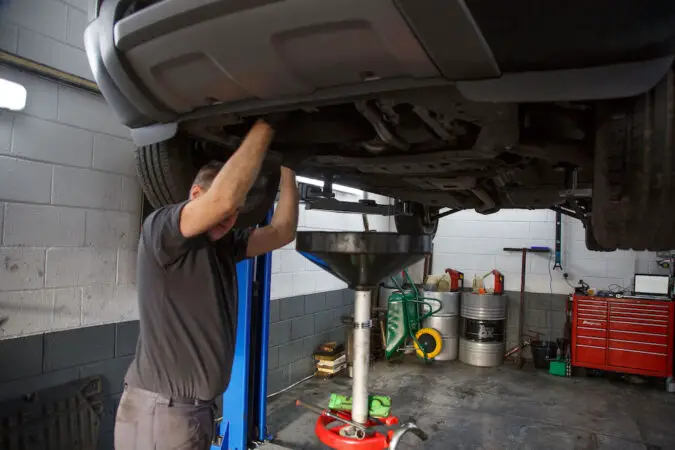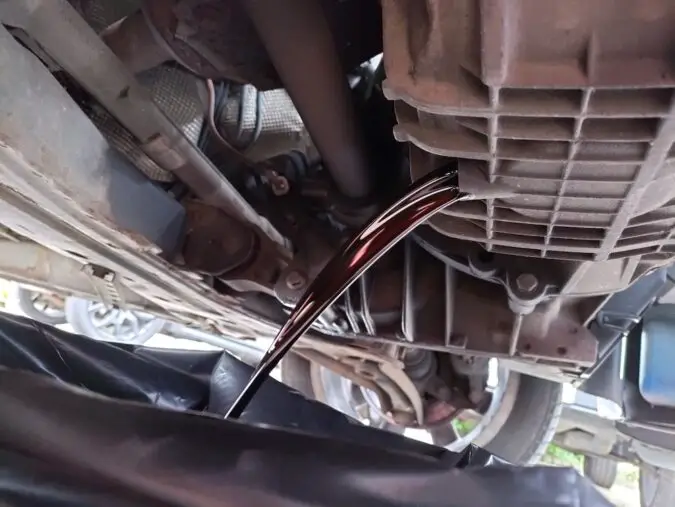Sure, your car needs to burn through gasoline or diesel for the engine to get you moving. But, if you don’t have motor oil to lubricate all those moving parts, the engine even won’t live through for that much longer than a few minutes. It’s for that reason why loads of people – including us – nag owners to keep on top of servicing the oil. But what are the bad oil pump symptoms that you should know?
After all, the oil needs to flow through loads of narrow passageways, galleries, and channels across the entire engine. It has to lubricate, cool, seal, and protect components like the camshaft, bearings, pistons, rings, valve stems, gaskets, seals, crankshaft, and countless more. With all this in mind, you ought to be diligent about the potential bad oil pump symptoms to keep that oil gushing along…
Oil Pump
Before we dive into the bad oil pump symptoms, we should first try to understand what the part in question actually does. So, what is an oil pump, anyway? In the old days, lubricants such as oil were applied manually.
In early automotive engines, motor oil was circulated using a drip-feed system, by essentially dripping the oil onto moving parts, and then collecting it with a tray or pan underneath.
Just to show you how primitive it was back then, ships employed folks called the ‘oilers’. They’d grab buckets or pots of oil, and carefully pour it over the ship’s engine. When the 1900s came along, it thankfully got better, and oil delivery became more advanced.
By this time, engines used a forced-feed system, where motor oil is pumped – or otherwise, forced-fed – to the engine’s componentry. Till today, this concept remains in place, where a forced-feed lubrication mechanism channels motor oil around at force.
The core of this system would be the aforementioned oil pump. It works first by sucking up oil from the oil pan at the bottom of the car by creating liquid suction. The oil pump can then create enough pressure to force the motor oil to flow around to the rest of the engine.
It channels through numerous passages – often referred to as ‘oilways’ – before then returning to the oil pan. From this sump, it’s then recirculated, and the process continues.
You can find the oil pump near the front of the engine in most cars, placed in or near the oil pan. The oil pump’s role is crucial, as its failure would result in the engine being starved of oil, as it can’t flow without it.
Engine Oil Pump Diagram
Since we’re looking into bad oil symptoms, it’s also vital to understand some of the many different parts that work alongside, and interacts with the oil pump. Here are some of the ones that you need to know the most.
They may not necessarily be a part of the oil pump or oiling system of your car, but they nonetheless have a part or two to play in its operations…
- Oil Pickup Pipe – This is a pipe that connects the pool of oil in the sump, to be delivered to the oil pump. The pipe here has its nozzle placed just below where the top surface of the oil should be.
- Oil Filter – It works just like an air filter, but for oil. Oil is supplied to the pump through the oil filter, which it filters out stray particles, large debris, contaminants, and so on. Otherwise, these could cause damage to the oil pump.
- Crankshaft – The crankshaft is definitely not a part of the oiling system, but it does help to distribute the motor oil. When the crankshaft rotates in a wet-sump-style engine, it will kick up and spray oil to the base of the pistons. Hence, lubricating them, and the piston rings.
- Sensors – Around the oil pump, there ought to be numerous sensors near the outlets. It’s here to monitor the flow and volume of oil. If the oil pressure drops, or if there’s an insufficient quantity of motor oil, the sensors will alert you with a dashboard warning light.
- Pressure Relief Valve – There will be a build-up of pressure as the oil starts flowing. Although, too much pressure can damage the engine, which is why there’s a pressure relief valve. When the pressure gets too high, this valve opens, and oil drops back down to the sump.
Oil Pump Types
We’ve explained a lot about the inner workings of oil pumps so far. Yet, did you know there could be different types of oil pumps? It turns out not all of them are the same, and these unique variations in design and engineering principles have their own ups and downsides, respectively.
In that case, what are the different types of oil pumps that you need to know about? Well, here are just a few examples of the most common types of oil pumps used in cars today…
1. Gear-Type Oil Pump
Perhaps the most conventional design of an oil pump used in vehicles for a little while now has been the gear-type pump. Its basics consist of two meshing gears, which can then rotate around inside a closed-fit pump housing.
Once those meshing gears start rotating, they will circulate the motor oil, and pressure it against the closed-fit housing. The teeth of the meshing gears will then force oil out of the oil pump, before the cycle repeats. There are plenty of upsides to using a gear-type oil pump, such as its simplicity.
That said, its flaws can be summarised in its ability to easily build up too much pressure inside the pump if the oil is too thick. This gear-type pump has, after all, very narrow clearances where oil can flow through. Thankfully, damage can be averted by the installation of a pressure relief valve.
2. Rotor Oil Pump
This design too is quite common these days, and you can find rotor oil pumps aplenty. Within it, you can find a rotor with up to four or five external lobes placed around it. These lobes then rotate inside an outer ring, which itself has another five or six internal lobes.
The axis of the inner and outer rotors are offset to one another for optimal efficiency. Plus, it makes sure that the rotation of the lobes can create a balanced volume of oil throughput. Oil is then pulled through the lobes and forced outwards through the pump’s discharge tube.
3. Eccentric Rotor Oil Pump
Of all the oil pumps that we’ve seen so far, this one might be the most familiar. The eccentric rotor oil pump is de rigueur in most modern automobiles and evolves the design of the rotor pump. You still have an inner and outer rotor, but this time is installed eccentrically to one another.
Each rotor, once again, will have a varying number of lobes. The inner lobe may have up to four that are mounted on the exterior. Meanwhile, the outer rotor may have up to five lobes that are facing inwards. The configuration of each eccentric-style oil pump does vary.
Nevertheless, there’s a common rule that the outer rotors will always have more lobes than the inner rotors. This eccentric pump design could sometimes be called the ‘crescent pump’, as there are crescent-shaped outlets and inlet ports for the oil to flow through.
The inner rotor rotates when the camshaft starts moving, which subsequently rotates the pump’s outer rotors, too. When this happens, motor oil is steadily forced through the inlet port and gets trapped between each opposing lobe on the inner and outer rotors.
As the rotors revolve faster, the clearance between the lobes will decrease. This helps to build up the pressure until the outlet port is opened. The edge of the rotors would pass by the outlet port, which could force the now-pressurized oil to exit and flow to the rest of the engine.
What Causes Oil Pump Failure
Thus far, we’ve learned quite a lot about oil pumps, such as what they do, and how they work. Still, there’s yet one more step that we have to take before discussing bad oil pump symptoms.
Namely, what’s causing your oil pump to go bad, anyway? Given its importance in the efficient, reliable, and operable functioning of your engine, surely the oil pump can’t give in too easily, no?
Well, it turns out there are more than a few causes as to why your oil pump fails and necessitates a replacement sooner or later. Here are some of the most typical reasons why oil pumps fail and thus exhibit bad oil pump symptoms…
1. Regular Wear And Tear
Generally, oil pumps organically wear out over time. As a piece of your engine, it goes through a lot of strain anytime your motor runs. The high pressures of the engine oil, as well as the intense heat, can wear the oil pump out after a while.
Although, they are made to be quite robust. Most oil pumps have a shelf-life of around 60,000 to 70,000 miles before a prompt replacement is needed. That said, these mileage estimates are only reserved for those who regularly maintain their cars and the condition of the oil.
2. Poor Maintenance
Speaking of maintenance, being behind on your servicing could play a huge role in wearing out your oil pump prematurely. Since the pump’s job is to circulate the oil around, running your car on old or burnt-out motor oil will have a serious impact on the health and well-being of that pump.
A practice as simple as getting an oil change every 3,000 to 6,000 miles – or every 3 to 6 months – is enough to avert this disaster. But what happens if you don’t change out the oil? Well, the motor oil would start accumulating debris, dirt, contaminants, and sometimes even metal shavings.
The latter is a residue left behind by your engine’s internal componentry as they naturally wear. All these particles can very easily contaminate the motor oil, as it gradually picks them up and dissolves them into the oil. Should this not be replaced after some time, the oil turns into a thick sludge.
It becomes a heavily viscous mixture, which is much harder to circulate and force through. The pump needs to work extra hard to create a pressure sufficient enough to move this sludge around. As a result, your engine’s contaminated oil will wear down the pump a lot quicker than usual.
3. Low Oil Levels
Even if you have clean and fresh oil (with some pointers on how to put oil in your car), an inadequate volume of motor oil in the system can lead to excessive wear on the pump. Always remember to fill your oil reservoir up to the manufacturer’s recommended amount. Otherwise, a lack of oil – perhaps due to a leak – can be dangerous.
The oil pump itself will go through more friction as it runs, as there isn’t enough oil around in the system to lubricate it. Additionally, the friction is made worse as the pump has to work harder to pressurize what little oil there is in the sump to the rest of the engine.
4. Wrong Oil Type
Remember how we mentioned the viscosity earlier? Well, be mindful that using the wrong type of oil in your car will also affect the longevity of the oil pump, as well as the rest of the car’s functions. Motor oil is sold in varying degrees of ‘oil grades’, or viscosity.
Each car is designed differently, so distinct models could use more or less viscous oil compared to the rest. If you’re using highly viscous oil in a car that isn’t designed for it, the oil pump is the first component to suffer from it. The intense pressure and thick flow could damage it over time.
Oil Pump Symptoms
Finally, we have what you came here for… What are all the bad oil pump symptoms that you need to be wary of? Let’s go back and remind ourselves of the importance of motor oil’s role in your car’s engine.
If there isn’t any oil, those many moving parts will grind, rub, scrape, and wear each other off. Within minutes, the engine can seize up, and then fail altogether. Apparently, an engine could last as long as 30 minutes without any motor oil in the system. But we don’t want to test that out, do we?
For this alone, let’s take a peek at the common symptoms and tell-tale signs of a bad oil pump. Once you experience it once, the best thing for you to do is to head over to a mechanic to have it checked out. Even better, have that pump replaced…
1. Low Oil Pressure
This is quite self-explanatory, really. First, there’s a common misconception that we need to clear up. Motor oil pressure is not created by the oil pump. For the most part, this increase in pressure is instead due to your engine oil being forced through narrow passages and channels as it circulates in your engine.
This pressure is normal and merely signals that your oil is flowing, as it should be. The oil pump only forces the oil out, and then back in, before pushing it out again. On top of that, the oil pump acts as a regulator for the pressure, ensuring that the oil pressure doesn’t get too high.
As we mentioned earlier, all those pumps up above have pressure relief valves. They can dump some of the oil back down to the sump if the oil pressure gets too much that it could damage the engine. With that in mind, a faulty or completely failed oil pump will affect the oil pressure.
The oil pump might not work anymore, hence no longer being able to circulate the flow of oil to the rest of the engine. This would result in a severe decrease in motor oil pressure, which will be alerted to you in the form of a warning light. For most cars, a ‘low oil’, or ‘low oil pressure’ light will appear.
You can diagnose this by checking your motor oil reservoir. If the oil level is too low, then top it up a bit more until it’s full. Should your ‘low oil pressure’ warning light still be blinking on the dash after the top-up, then it could be a sign that your oil pump may be a goner.
2. High Oil Pressure
On the flip side of things, a faulty oil pump may also contribute to unusually high oil pressures. When this occurs, it can be as damaging – if not more so – to your engine than having too little motor oil. So, how could it be that a defective oil pump through up too high of oil pressure?
Well, remember that pressure relief valve? Well, it’s possible that the valve itself – as a part of the oil pump – is what’s failed. If the pressure relief valve breaks, it can’t dump out oil should the pressure get too much. In this case, it’ll keep building up and up, until you see a blinking check engine light.
3. Increased Engine Temperatures
While we mostly recognize motor oil as a lubricant, it’s technically a part-coolant, as well. As the oil flows around, it carries away some of the heat from your engine’s innards and moving parts and brings it back to the oil sump. Here, the motor oil can be cooled down.
Moreover, and as the oil prevents those moving components from rubbing or scraping against each other, this lack of friction contributes to lesser heat inside the engine. But what if the oil pump were to fail? In this scenario, motor oil won’t be able to reach the engine.
It can’t lubricate your engine’s many parts, which would in turn emit more friction. As it grinds on one another, this friction will create a lot more heat within the engine. Furthermore, the absence of oil means that it can’t carry the heat away from the engine.
Sure, your coolant might still be working fine, but it alone can’t prevent an increase in temperature. You’ll soon see the temperature gauge in the dash climb high up before it starts flashing at you. If your engine is overheating, you should have it looked into immediately to prevent any damage.
4. Noises From The Valvetrain
But, you might ask, what is a valvetrain? Well, the valvetrain sits at the top of your engine, usually accompanying the camshaft. As the name suggests, your engine’s valvetrain consists of a series of valves. All of whom are tasked with controlling the intake and exhaust valves of the engine.
In other words, the valves let in air and fuel to be mixed and ignited within the combustion chamber, before letting them exhaust out. Suffice it to say, the valvetrain is pivotal in the actual working of an internal combustion engine. The valvetrain is maintained, in part, by the motor oil.
The oil lubricates the valvetrain’s hydraulic lifters, pushrods, seals, valve guides, and so on. Overall, the performance of these components is dependent on whether motor oil can reach them, or not. So, what’s the consequence of it if your oil pump breaks?
If they aren’t sufficiently lubricated, the valvetrain can seize up and stop working altogether. This is catastrophic for your engine and can lead to engine failure. An early warning sign can be heard as unusual noises from the engine, owing to metal-on-metal contact of the valvetrain.
5. Noises From The Oil Pump
The oil pump shouldn’t make any noises whatsoever. Ordinarily, it works quietly in the background, never to be noticed. While this is quite a rare symptom, the oil pump can make sounds when its time is due. However, this is only noticeable when the pump is already on the verge of complete failure.
Namely, you can hear these strange whirring or whining noises, even if your car is left idling. It’s most likely that the gears inside the oil pump are what’s at fault. As they’re worn out, you can get away with repairing or replacing these gears, instead of springing up for a whole new oil pump.
Bad Oil Pump Symptoms: Fixes, Costs, And Summary
Alas, the oil pump, though a reliable and trustworthy unit of your engine, will need a replacement at some point. Preferably, it should be done before the bad oil pump symptoms crop up, or right when they appear.
Unfortunately, replacing the oil pump isn’t what some might call, ‘cheap’. It’s quite a major expense, and will vary depending on your vehicle, and what type of pump you use. The part itself isn’t terribly expensive. New oil pumps can be found for $100 to $300 on average.
But where it really bites is the hourly labor costs. Replacing the oil pump is a tedious task, and will take even a trained mechanic a couple of hours or longer to complete. On top of that, you ought to then consider replacing some of the other oily bits and pieces while getting the pump replaced.
These can include the oil pan gasket, pump gasket, oil filter, and maybe an oil flush, too. Add it all up, and a total oil pump replacement cost will tally around $500 to $1,300. Again, it’s not cheap to replace that oil pump. But compared to the $3,000 or more that you’ll have to pay for a brand new engine as a consequence of ignoring bad oil pump symptoms, it’s not a bad deal after all.
FAQs On Bad Oil Pump Symptoms
If you’re still curious to learn more about bad oil pump symptoms, our FAQs here might help…
What Causes Low Oil Pressure
There are many reasons why your engine’s oil pressure is low. Among the most common causes of low oil pressure is a low oil level. If there’s not enough oil circulating in the engine, it’ll be hard for your car’s oiling system to pressurize it properly. Beyond that, too high or too low of an oil viscosity will also impact the oil pressure. Therefore, you’ll have to make sure that you’re using the right type of oil that’s been designed to work best with your engine. Elsewhere, you’ll need to look at the oil pump. A bad pump will essentially fail to thoroughly pressurize the motor oil passing through it, causing a drop in pressure. Similarly, clogged oil filters have the same effect.
How To Tell If Engine Is Damaged From No Oil
Running an engine without any oil (or an insufficient amount of oil) is a very bad idea. Doing this alone could kill an engine within minutes of you starting it. That’s due to the fact that motor oil is necessary to not only manage the internal working temperature of the engine. But also, to provide essential lubrication and prevent metal parts from grinding each other down. Thus, causing significant damage. There are tell-tale signs that precede complete engine failure, though. Among them includes an oil pressure warning light, as well as a burning oil smell. Beyond that, you might notice grinding sounds, smoke coming from the engine, a spiking temperature gauge, and poor performance.
What Should My Oil Pressure Be
Your car’s engine oil pressure isn’t a constant, as it will vary, depending on the situation. Typically, the oil pressure should be around 20 to 30 psi while you’re idling. As you begin driving and pick up speed, more oil circulation is required, thus raising the oil pressure to between 45 to 70 psi. When you’ve just started up your car and notice a warning light for the oil pressure, it might be because the pressure’s dropped to merely 5 to 10 psi at idle. This is too low for oil to meaningfully circulate throughout your engine. Meanwhile, seeing anything higher than 80 psi is far too much. The pressure is so high, that the oil might fail to sufficiently lubricate the engine.
How Do Oil Pumps Work
A car’s engine requires oil for both cooling and lubrication. Thus, allowing it to run reliably, smoothly, efficiently, and continue doing so for a long time. The oil pump in your car fulfills this role, by providing the necessary pumping pressure to help circulate the oil throughout your engine. Oil pumps are either found inside or outside (though still near) the oil pan. Oftentimes, the oil pump is driven by either the camshaft or the crankshaft. As such, once the engine begins cranking and is up and running, this will run the oil pump, as well. With it working, it’ll start pumping oil from the oil pan and through the oil filter, before forcing it through narrow passageways and galleries.
How Much Is An Oil Pump
Replacing a car’s oil pump is typically a costly affair. Although, the pump itself can be found for relatively cheap. While some pumps might cost you $300, most off-the-shelf third-party units can be picked up for around $100 or sometimes less. However, it’s the labor costs that eventually cause the repair bill to skyrocket. This is due to the oil pump’s oft-hard-to-reach location. Therefore, even a skilled mechanic might take several hours of work to access and eventually replace the pump. In total, replacing your oil pump may cost you anywhere between $500 to $1,300. While you’re there, you might also consider replacing the oil pan gaskets, oil filter, and do an oil flush, too.




